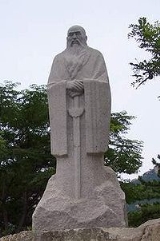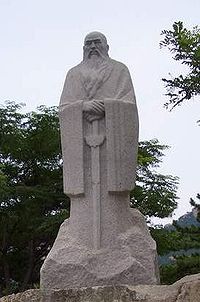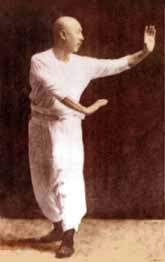
List of lei tai fighters
Encyclopedia
Many martial artists
have become famous lei tai fighters because of their successful matches upon the raised fighting stage. Others were already famous before facing lei tai challengers. This is not a definitive list:



If the examples of Wong Yan Lin and Chen Zhao Pi are used, it took anywhere from 17–18 days and at least 150-200 consecutive wins in order for a fighter, who set up his own lei tai, to establish his style
's dominance in that area.
Martial arts
Martial arts are extensive systems of codified practices and traditions of combat, practiced for a variety of reasons, including self-defense, competition, physical health and fitness, as well as mental and spiritual development....
have become famous lei tai fighters because of their successful matches upon the raised fighting stage. Others were already famous before facing lei tai challengers. This is not a definitive list:

Song Dynasty
- Northern Praying Mantis founder Wang Lang (王朗) participated in a lei tai tournament, according to legend, where he was defeated by TongbeiTongbeiquanTongbeiquan is a school of martial arts popular in northern China. Tongbeiquan's basic precepts are Taoist in nature and many of the training methods in Tongbeiquan are similar to those of the internal styles...
(通揹) Master Han Tong (韩通) in the capital of KaifengKaifengKaifeng , known previously by several names , is a prefecture-level city in east-central Henan province, Central China. Nearly 5 million people live in the metropolitan area...
. Master Lang shortly thereafter created his famous mantis fist.
Qing Dynasty

- Lama Pai Master Wong Yan Lin set up his own lei tai platform in front of Hai Tung Monastery in GuangdongGuangdongGuangdong is a province on the South China Sea coast of the People's Republic of China. The province was previously often written with the alternative English name Kwangtung Province...
after having worked as a famous bodyguard in Northern ChinaNorthern and southern ChinaNorthern China and southern China are two approximate regions within China. The exact boundary between these two regions has never been precisely defined...
. For 18 days, he fought 150 other martial artists and was never defeated. According to Hop Gar Grandmaster David Chin, "Either the challenger was maimed or killed. Wong never let one challenger leave his school without injury. He was a master of using the technique of cruelty." Shortly afterwards, he was elected as the leader of the Ten Tigers of CantonTen Tigers of CantonThe Ten Tigers of Canton or Ten Tigers of Guangdong refer to a group of ten Chinese martial artists from Guangdong , China, who lived during the late Qing Dynasty . They were said to be the best fighters in southern China at that time...
, who were the top ten kung fu men in Guangdong.
- Tiger-Crane Master Tee Ley was known for killing his opponents on the lei tai. But years after retiring from the martial world to become a cobblerShoemakingShoemaking is the process of making footwear. Originally, shoes were made one at a time by hand. Traditional handicraft shoemaking has now been largely superseded in volume of shoes produced by industrial mass production of footwear, but not necessarily in quality, attention to detail, or...
, he accepted a challenge from a northern Chinese Master and killed him with a mix of Tiger-Crane and Iron PalmIron PalmIron Palm or Iron Hand is a body of training techniques in various Chinese martial arts. These conditioning techniques are typically meant to condition the hands to allow a practitioner to deliver very powerful blows without injury to his or her hands.-Overview:Iron Palm is a broad term covering...
techniques. He was a disciple of Chee See Tsek.
- MízōngyìMizongyiMízōngyì , or simply Mízōng, is a style of Chinese martial art based on deception and mobility. Mizong is also known as Mízōngquán and Yanqingquan and there are many sub-branches of this style....
Master Huo Yuan JiaHuo YuanjiaHuo Yuanjia was a Chinese martial artist and co-founder of Chin Woo Athletic Association, a martial arts school in Shanghai...
(c. 1867-1910) was the founder of the Chin Woo Athletic AssociationChin Woo Athletic AssociationChin Woo Athletic Association is a Chinese martial arts association founded in Shanghai on July 7, 1910, but other sources also cite dates in 1909. It can be found spelled in many ways - Jing Mo, Ching Wu, Jing Wo, Jing Wu etc....
, a martial arts school in Shanghai. He is considered a hero in China for challenging foreign fighters in highly publicized matches at a time when Chinese sovereignty was being eroded by foreign concessions and spheres of influence.
Republic of China

- Internal martial arts Master Chang Chan Kuei (1859–1940, Zhang Zhan Kui), also known as Chang Chao Tung (Zhang Zhao Dong), made a name for himself on the lei tai by defeating several Japanese boxers and a German Strongman. He was also one of the eight famous students of Dong Hai ChuanDong HaichuanDong Haichuan was born on the 13th of October 1797 in Zhu village, Ju Jia Wu Township, Wen'an County, Hebei Province, China and died on the 25th of October 1882 in Beijing. He is regarded as a skillful martial artist and is widely credited to be the founder of Baguazhang...
, the founder of BaguazhangBaguazhangBāguàzhǎng is one of the three main Chinese martial arts of the Wudang school, the other two being Taijiquan and Xingyiquan. It is more broadly grouped as an internal practice...
boxing.
- 17th generation Chen-style t'ai chi Master Chen FakeChen FakeChen Fake or Chén Fākē or Ch'en Fa-k'e 陳發科 was a famous Chinese Taijiquan teacher. Born and raised in Chen Family Village in Henan province, he was the 17th generation lineage holder of Chen-style taijiquan...
(1887–1957), became famous in his hometown of Chénjiāgōu (陳家溝) for his victories upon the lei tai.
- Tai-chi Praying Mantis Master Wang Yu Shan (王玉山) (1892–1976) ranked high in the 1933 Central Kuoshu Institute lei tai competition and earned the martial nickname “Steel Hands and Iron Fists”. He was one of the Laiyang Sanshan ("Three Mountains of Laiyang"), the three greatest Mantis boxers in LaiyangLaiyangLaiyang city is a city between Yantai and Qingdao, located at the middle of Shandong peninsula, China. Majority of its population are farmers and it is famous for Laiyang Pear...
at the time.
- 18th generation Chen-style t'ai chi Master Chen Zhao Pi (陈照丕) (1893–1972), Chen Fake's third nephew, was hired to guard the famous "Tong Ren Tang" (Le Brothers) pharmacy in BeijingBeijingBeijing , also known as Peking , is the capital of the People's Republic of China and one of the most populous cities in the world, with a population of 19,612,368 as of 2010. The city is the country's political, cultural, and educational center, and home to the headquarters for most of China's...
in 1928. He kept a low profile by disguising himself as a street vender, wishing to avoid conflict with other martial artists. However, the scholar Li Qin Lin (also from Henan province) wrote an unauthorized article in the Beijing Times newspaper describing the superiority of Chen-style t'ai chi to other styles in the area. In its conclusion, the article asked the masses who had not experienced Chen-style to "try it out" since a Chen master (Chen Zhao Pi) was currently living in Beijing.
- The local martial arts schools saw the article as a “challenge” and so Chen Zhao Pi was urged to set up a lei tai by the Xuan Wu Men, one of the city's many gates. At first, challengers came one at a time, but eventually thronged to the lei tai in groups of threes and fives. Over the course of 17 days, he defeated over two hundred people and made many friends.
- Northern Shaolin Master Gu Ru Zhang (顾汝章) (1893–1952) placed in the “Top 15" (other sources say "Top 10") finishers in the 1928 Central Kuoshu Institute lei tai competition. He was famously known as "Iron PalmIron PalmIron Palm or Iron Hand is a body of training techniques in various Chinese martial arts. These conditioning techniques are typically meant to condition the hands to allow a practitioner to deliver very powerful blows without injury to his or her hands.-Overview:Iron Palm is a broad term covering...
Gu Ru Zhang".
- Plum Blossom Praying Mantis Master Li Kun Shan (1894–1976) won the weapons portion of the 1933 Central Kuoshu Institute lei tai competition using the long spear. He was one of the Laiyang Sanshan ("Three Mountains of Laiyang"), the three greatest Mantis boxers in LaiyangLaiyangLaiyang city is a city between Yantai and Qingdao, located at the middle of Shandong peninsula, China. Majority of its population are farmers and it is famous for Laiyang Pear...
at the time.
- lying Dragon Tiger Gate Master Leung Tian Chiu was 55 years old when he won 2nd place in the 1928 Central Kuoshu Institute lei tai competition. He went on to create his own martial arts styles called Fut Gar Kuen (“Buddhist Fist Boxing”) and Sae Ying Diu Sao (“Snake Form Mongoose Hands”), which was featured in an old Jackie Chan movie.
- Seven Star Praying Mantis Master Ma Cheng Xin (馬成鑫) won the grand championship of lei tai at the national Chinese boxing competition in 1929. Ma was a student of famed Mantis boxer Luo Guang Yu (羅光玉), who later taught his style at the Chin Woo Athletic AssociationChin Woo Athletic AssociationChin Woo Athletic Association is a Chinese martial arts association founded in Shanghai on July 7, 1910, but other sources also cite dates in 1909. It can be found spelled in many ways - Jing Mo, Ching Wu, Jing Wo, Jing Wu etc....
.
- Xinyi Liu HeXingyiXingyi may refer to:*Xingyiquan, one of the major internal Chinese martial arts*Xingyi, Guizhou, county level city in Guizhou, China...
Master Shang Xueli won the lei tai competition in Kaifeng where he used a combination of "Back Power" (Bei Jin) and knee strike (Ti Xi) defeating Shaolin expert, Zhang Qilin (who died a few days later of internal injury). He was the disciple of Mai Zhuangtu (1829–1892) and Yuan Fengyi, master of Grandmaster Lu Songgao (卢嵩高) (d. 1962).
- Zhaobao Taichi Master Zheng Bo Ying (鄭伯英) (1904–1961) became famous after winning the 1931 lei tai competition held in KaifengKaifengKaifeng , known previously by several names , is a prefecture-level city in east-central Henan province, Central China. Nearly 5 million people live in the metropolitan area...
.
- XingyiXingyiXingyi may refer to:*Xingyiquan, one of the major internal Chinese martial arts*Xingyi, Guizhou, county level city in Guizhou, China...
Master Xin Jian Hou won a lei tai contest in 1931. He was one of the earliest disciples of Shang Yun Xiang (1864–1937), who was a disciple of Guo Yun ShenGuo YunshenGuo Yunshen was a famous Xingyiquan master. He represented the xingyi martial philosophy of preferring to become highly proficient with only a few techniques rather than to be less proficient with many techniques...
.
- Shuai JiaoShuai jiaoShuai jiao is the general Mandarin Chinese term for wrestling. As a generic name, it may be used to cover various styles of wrestling practised in China in the form of a martial arts system or a sport. The narrower term pertains to wrestling styles of the North China Plain...
Master Chang Tung ShengChang Tung ShengChang Tung Sheng was a Hui martial artist. He was one of the best-known Chinese wrestling practitioners and teachers....
(1908–1986) won the heavy weight division of the 1933 Central Kuoshu Institute lei tai competition and earned the martial nickname “Flying Butterfly”;
People’s Republic of China
- HuiHui peopleThe Hui people are an ethnic group in China, defined as Chinese speaking people descended from foreign Muslims. They are typically distinguished by their practice of Islam, however some also practice other religions, and many are direct descendants of Silk Road travelers.In modern People's...
-Muslim Grandmaster Ma XiandaMa XiandaMa Xianda was born in 1932 to a Muslim Hui family in Hebei whose association with martial arts goes back six generations. Ma Xianba was taught by his father Ma Fengtu and uncle Ma Yintu...
(馬賢達) (1932–present) defeated TongbeiTongbeiquanTongbeiquan is a school of martial arts popular in northern China. Tongbeiquan's basic precepts are Taoist in nature and many of the training methods in Tongbeiquan are similar to those of the internal styles...
master Deng Hong Zhao and ChuojiaoChuojiaoChuōjiǎo is a Chinese martial art that comprises many jumps, kicks, and fast fist sequences. The fist and feet work in unison and strike continuously forward, like “falling meteorites”, never giving the opponent a moment to recover. The qinggong portion of this style's training involves a...
master Li Xue Wen to win the lei tai championship of 1952. Ma is the youngest of the four living top-ranking masters in ChinaChinaChinese civilization may refer to:* China for more general discussion of the country.* Chinese culture* Greater China, the transnational community of ethnic Chinese.* History of China* Sinosphere, the area historically affected by Chinese culture...
. He is considered a “National Treasure in Wushu”.
- Internal martial arts Master Su Dong Chen (1953–present) participated in lei tai bouts throughout the late 60's and early 70's as a teenager. He was known as the “Gifted child of Lei tai”.
- Sanshou boxer Cung LeCung LeCung Le is a Vietnamese-American Sanshou kickboxer, mixed martial artist, and actor from Saigon, Vietnam currently competing in the UFC. He is the former IKF Light Heavyweight San Shou World Champion and has a professional San Shou record of 16-0 before moving to mixed martial arts...
(1972–present), the current 2008 Strikeforce Middleweight MMAMixed martial artsMixed Martial Arts is a full contact combat sport that allows the use of both striking and grappling techniques, both standing and on the ground, including boxing, wrestling, Brazilian jiu-jitsu, muay Thai, kickboxing, karate, judo and other styles. The roots of modern mixed martial arts can be...
Champion, made a name for himself upon the lei tai before going professional. Le was awarded the “most famous Vietnamese Martial Artist in the world” title at the 2004 Asia Entertainment Awards in Los Angeles.
If the examples of Wong Yan Lin and Chen Zhao Pi are used, it took anywhere from 17–18 days and at least 150-200 consecutive wins in order for a fighter, who set up his own lei tai, to establish his style
Chinese martial arts
Chinese martial arts, also referred to by the Mandarin Chinese term wushu and popularly as kung fu , are a number of fighting styles that have developed over the centuries in China. These fighting styles are often classified according to common traits, identified as "families" , "sects" or...
's dominance in that area.

